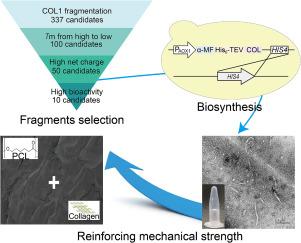具有生物活性的人源胶原I-PCL复合材料的开发及其在组织工程中的应用
IF 6
2区 医学
Q2 MATERIALS SCIENCE, BIOMATERIALS
Materials Science & Engineering C-Materials for Biological Applications
Pub Date : 2025-08-19
DOI:10.1016/j.bioadv.2025.214461
引用次数: 0
摘要
胶原的分层组装严重影响其生物活性,其中I型胶原(COL1)对组织组织和细胞粘附尤为重要。本研究旨在鉴定出可由毕赤酵母生物合成并保留功能性生物活性的COL1片段。我们根据更高的热稳定性(Tm)、净电荷和预测的生物活性对COL1进行片段化和选择变异。10个变体中有3个在4°C条件下成功分泌并形成三螺旋结构。在实际应用中,我们重点研究了两种在15°C以上保持三螺旋构象的变体,并通过显微镜和流变分析进一步证实了它们的高阶结构。变体COL109对成骨细胞分化的促进作用增强,但在制备水凝胶时表现出较弱的机械强度。为了解决这个问题,我们通过将其与(GPP)₁₀motif的粘合标签融合来增强其结构完整性。由此产生的COL109(GPP)₁₀结构显示出更高的机械强度。此外,我们将COL109(GPP)₁₀与聚已内酯(PCL)结合起来,表明较高的PCL浓度增加了机械强度,但降低了生物活性和保水性,而COL109(GPP)₁₀与PCL的1:1比例达到了最佳平衡。通过促进伤口愈合和细胞分化,该复合材料在组织工程中具有很强的应用潜力。本文章由计算机程序翻译,如有差异,请以英文原文为准。

Development of bioactive humanized collagen I-PCL composites with enhanced mechanical properties for tissue engineering applications
The hierarchical assembly of collagen critically affected its biological activity, with type I collagen (COL1) being especially important for tissue organization and cell adhesion. This study aimed to identify COL1 fragments that could be biosynthesized by Pichia pastoris while retaining functional bioactivity. We fragmented COL1 and selected variants based on higher thermal stability (Tm), net charge, and predicted bioactivity. Three of the ten variants were successfully secreted by P. pastoris and formed triple-helix at 4 °C. For practical applications, we focused on two variants that maintained their triple-helical conformation above 15 °C, and further confirmed their higher-order structures using microscopy and rheological analysis. The variant COL109 demonstrated enhanced promotion of osteoblast differentiation but exhibited weak mechanical strength when preparing hydrogels. To address this, we enhanced its structural integrity by fusing it with an adhesion tag of (GPP)₁₀ motif. The resulting construct of COL109(GPP)₁₀ showed improved mechanical strength. Furthermore, we combined COL109(GPP)₁₀ with polycaprolactone (PCL), showing that higher PCL concentrations increased mechanical strength but reduced bioactivity and water retention, while a 1:1 ratio of COL109(GPP)₁₀ to PCL achieved an optimal balance. By promoting wound healing and cell differentiation, the composite demonstrates strong potential for use in tissue engineering.
求助全文
通过发布文献求助,成功后即可免费获取论文全文。
去求助
来源期刊
CiteScore
17.80
自引率
0.00%
发文量
501
审稿时长
27 days
期刊介绍:
Biomaterials Advances, previously known as Materials Science and Engineering: C-Materials for Biological Applications (P-ISSN: 0928-4931, E-ISSN: 1873-0191). Includes topics at the interface of the biomedical sciences and materials engineering. These topics include:
• Bioinspired and biomimetic materials for medical applications
• Materials of biological origin for medical applications
• Materials for "active" medical applications
• Self-assembling and self-healing materials for medical applications
• "Smart" (i.e., stimulus-response) materials for medical applications
• Ceramic, metallic, polymeric, and composite materials for medical applications
• Materials for in vivo sensing
• Materials for in vivo imaging
• Materials for delivery of pharmacologic agents and vaccines
• Novel approaches for characterizing and modeling materials for medical applications
Manuscripts on biological topics without a materials science component, or manuscripts on materials science without biological applications, will not be considered for publication in Materials Science and Engineering C. New submissions are first assessed for language, scope and originality (plagiarism check) and can be desk rejected before review if they need English language improvements, are out of scope or present excessive duplication with published sources.
Biomaterials Advances sits within Elsevier''s biomaterials science portfolio alongside Biomaterials, Materials Today Bio and Biomaterials and Biosystems. As part of the broader Materials Today family, Biomaterials Advances offers authors rigorous peer review, rapid decisions, and high visibility. We look forward to receiving your submissions!

 求助内容:
求助内容: 应助结果提醒方式:
应助结果提醒方式:


